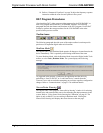
Digital Audio Processor with Room Control Crestron C2N-DAP8RC
24 • Digital Audio Processor with Room Control: C2N-DAP8RC Operations Guide - DOC. 8187A
NOTE: The Philips Pronto model transmitter contains built-in RC5 commands for
out-of-the-box use. The Pronto transmitter’s RC5 System Number is equivalent to
the Crestron Transmitter ID; similarly, the RC5 Command Number is equivalent to
the Crestron Button ID. This means that setting up the Phillips Pronto requires only
the code verification procedure described below, but not the mapping procedure.
NOTE: The Phillips Pronto can also generate non-RC5 codes.
Code Verification
All IR transmitters provide manufacturer’s documentation that lists IR codes by
device and manufacturer. Code verification involves choosing the appropriate code
so that the transmitter can communicate with the C2N-DAP8RC. This requires the
following:
• Crestron interface box, such as C2N-DAP8RC, connected to CNXRMIRD
• PC running the Crestron Viewport. The Crestron Viewport is available as a
pull-down command from SIMPL Windows or Crestron VisionTools
®
Pro-e (VT Pro-e), or as a standalone utility
• Crestron control system connected to the PC (the control system should be
running a valid SIMPL Windows program so that the C2N-DAP8RC can be
polled)
The procedure is completed as follows:
1. From the Viewport Diagnostics menu, select Identify Transmitter ID. The
Viewport will check the baud rate and then display the "Transmitter
Identification" window.
2. Point the transmitter at the CNXRMIRD and select a code, as outlined in
the manufacturer's documentation.
3. Press a button on the transmitter and take note of the "Transmitter
Identification" window.
4. If no activity is listed next to Button Action, the code is not acceptable.
Repeat steps 2 and 3 with another code. If activity is indicated next to
Button Action with each button press, the code was successfully
programmed.
Once the code has been successfully programmed, the transmitter is automatically
assigned a unique hexadecimal Transmitter ID that can range from 00 to 3F.


















